The Concert Halls And Theatres Market is estimated to be valued at USD 190.3 billion in 2025 and is projected to reach USD 310.0 billion by 2035, registering a compound annual growth rate (CAGR) of 5.0% over the forecast period. The market’s growth is fueled by rising consumer interest in live entertainment, cultural performances, and theatrical productions across both mature and emerging markets. From 2025 to 2027, the market is expected to increase from USD 190.3 billion to nearly USD 209.8 billion, supported by enhanced venue capacities, improved event experiences, and a gradual return of large-scale shows post-pandemic disruptions. The period also benefits from expanding audience bases due to greater accessibility and diversified programming, including music concerts, plays, dance performances, and multimedia events.
Between 2028 and 2030, the market further climbs to USD 242.9 billion as more investments are directed towards upgrading infrastructure, integrating advanced audio-visual systems, and increasing the number of performances globally. This half-decade growth phase sees steady ticket sales and increasing demand for premium and exclusive live entertainment experiences, reinforcing the sector’s strong position within the broader cultural and leisure industries. By 2030, concert halls and theatres will remain essential venues for artistic expression and social gathering, driving continued revenue growth.
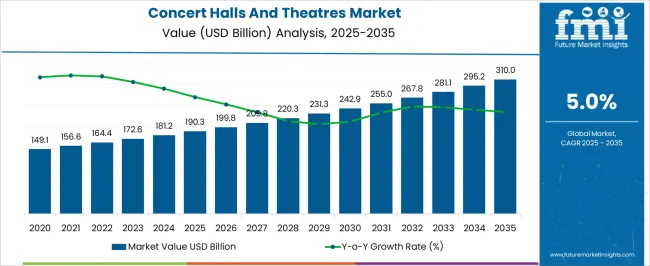
| Metric | Value |
|---|---|
| Concert Halls And Theatres Market Estimated Value in (2025 E) | USD 190.3 billion |
| Concert Halls And Theatres Market Forecast Value in (2035 F) | USD 310.0 billion |
| Forecast CAGR (2025 to 2035) | 5.0% |
The concert halls and theatres market is experiencing a resurgence in growth, influenced by evolving consumer preferences for live cultural experiences, technological integration in performance spaces, and increased government and private sector investments in arts infrastructure. Urban redevelopment initiatives and heritage preservation projects are revitalizing historic venues while supporting the construction of modern, acoustically advanced facilities.
Operators are increasingly leveraging digital ticketing, live-streaming integration, and hybrid programming to expand audience reach and improve engagement. As tourism rebounds and experiential spending grows, demand for diverse and immersive entertainment formats is rising.
The shift toward community-centric programming and multifunctional venue use is further broadening revenue streams, with institutions adopting data-driven strategies to optimize event planning and audience targeting. Going forward, innovation in sound engineering, climate control, and accessibility design is expected to shape the evolution of concert halls and theatres across global cultural hubs.
The concert halls and theatres market is segmented by type, programming & event frequency, and geographic regions. By type, the concert halls and theatres market is divided into Theatres, Concert halls, and Opera houses. In terms of programming & events of the concert halls and theatres market, it is classified into Live events and performances, Classical music concerts, Opera performances, and Theatre productions. Based on event frequency of the concert halls and theatres, the market is segmented into Year-round, Seasonal, and Special. Regionally, the concert halls and theatres industry is classified into North America, Latin America, Western Europe, Eastern Europe, Balkan & Baltic Countries, Russia & Belarus, Central Asia, East Asia, South Asia & Pacific, and the Middle East & Africa.
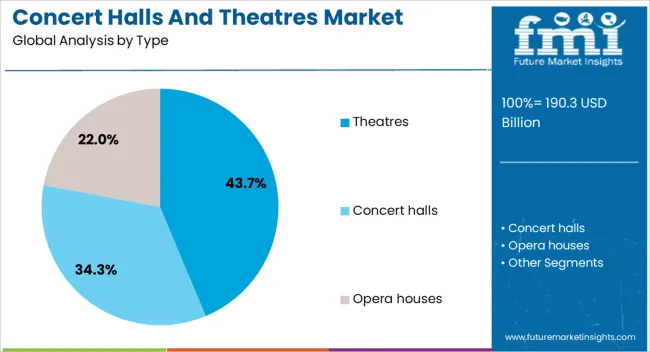
Theatres are expected to account for 43.7% of the market revenue in 2025, making them the leading facility type in the concert halls and theatres market. This segment's dominance is attributed to their historical and cultural significance, architectural adaptability, and suitability for a broad range of performances, including drama, dance, and multimedia storytelling.
Theatres offer optimized acoustics and sightlines, providing an immersive experience that continues to attract loyal audiences. Their ability to host a high volume of performances across genres, along with support from public arts funding and nonprofit partnerships, has reinforced their financial and operational resilience.
As content creators increasingly collaborate with theatres for experimental and thematic productions, the relevance and utilization of these venues remain strong within urban and regional entertainment ecosystems.
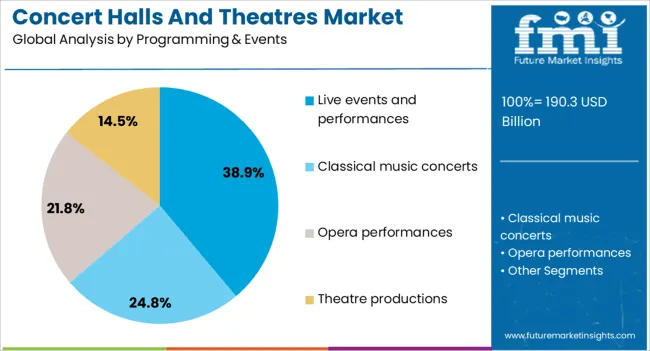
Live events and performances are projected to hold 38.9% of the market share by 2025, representing the top programming and event format. The segment's strength lies in its ability to deliver real-time audience engagement and emotional connection, which continues to outperform passive media formats in terms of consumer impact.
Growth has been fueled by rising interest in immersive and interactive entertainment, with venues investing in lighting, sound, and stage innovation to elevate the live experience. Artist tours, local talent showcases, and seasonal programming have also expanded diversity in event offerings, attracting both regular and first-time attendees.
As sponsors and content platforms seek deeper audience penetration, live programming remains central to monetization and outreach strategies within the cultural venue landscape.

Year-round events are anticipated to contribute 52.4% of the total revenue in 2025, positioning them as the dominant frequency segment. Continuous programming ensures high facility utilization, stable staffing models, and consistent revenue flows.
Institutions with year-round operations are better positioned to build community loyalty, secure long-term partnerships, and diversify their audience base through varied seasonal line-ups. This model allows venues to balance headline acts with educational, local, or niche performances, fostering inclusivity and content variety.
Additionally, stable year-round scheduling enhances ticketing predictability, improves maintenance planning, and supports the development of subscription or membership-based attendance models. In a competitive entertainment landscape, maintaining relevance through regular engagement has become a strategic imperative, making year-round programming the most sustainable operational approach.
The concert halls and theatres market is evolving as cultural institutions and private operators adapt to changing consumer preferences and technological advancements. Demand for live performances remains strong, supported by interest in music, drama, dance, and other performing arts. Renovation and modernization of historic venues, alongside new constructions, are driving market growth. Challenges include high operational costs, competition from digital entertainment, and fluctuating attendance due to economic conditions. Opportunities arise from integrating immersive technologies, expanding educational programming, and diversifying revenue streams through events and partnerships.
Live performances are experiencing renewed interest as audiences seek authentic, communal cultural experiences. Concert halls and theatres offer unique atmospheres that cannot be replicated through digital media, fostering emotional connections and shared social moments. Increasing demand for diverse programming, including classical music, contemporary performances, and multicultural events, is broadening audience bases. Venue operators are collaborating with artists, festivals, and local communities to create dynamic schedules that appeal to varied demographics. Additionally, increased tourism and urban cultural investments in many regions are stimulating construction and renovation of performance spaces, enhancing market expansion.
Managing concert halls and theatres involves significant financial commitments, including facility maintenance, staffing, and production expenses. Historic venues often require costly restoration and compliance with safety regulations, which can strain budgets. Seasonal and event-driven attendance can lead to inconsistent revenue streams, complicating financial planning. The high cost of technology upgrades, such as advanced sound and lighting systems, further adds to operational burdens. Moreover, competition from streaming platforms and at-home entertainment options affects ticket sales, particularly among younger audiences. Operators are focusing on efficient resource management, strategic scheduling, and diversified programming to mitigate these challenges and ensure long-term sustainability.
Concert halls and theatres are increasingly incorporating immersive and interactive technologies to enhance visitor engagement. Innovations such as augmented reality, advanced acoustics, and dynamic lighting systems enrich live performances and attract tech-savvy audiences. Online ticketing platforms, virtual tours, and live-streamed events expand access beyond physical attendees, creating new revenue opportunities. Some venues offer hybrid formats combining in-person and virtual experiences to reach wider audiences, especially following the impacts of recent global disruptions. Technology also supports educational outreach and community engagement programs. Investing in these advancements helps venues stay competitive and relevant in an evolving entertainment landscape while appealing to diverse audience preferences.
Regions with strong cultural traditions and government support are witnessing significant growth in concert hall and theatre infrastructure. Europe and North America lead with numerous iconic venues and active funding for the arts, encouraging ongoing renovations and new projects. Asia Pacific is emerging rapidly, with growing investments in cultural districts and performance centers to meet rising urbanization and tourism demand. The Middle East and Latin America are also increasing funding for cultural infrastructure as part of broader economic diversification strategies. Enhanced global travel and international events boost attendance and cross-border collaborations. Regional growth is fueled by public-private partnerships, philanthropy, and corporate sponsorships that support vibrant performing arts ecosystems and audience development.
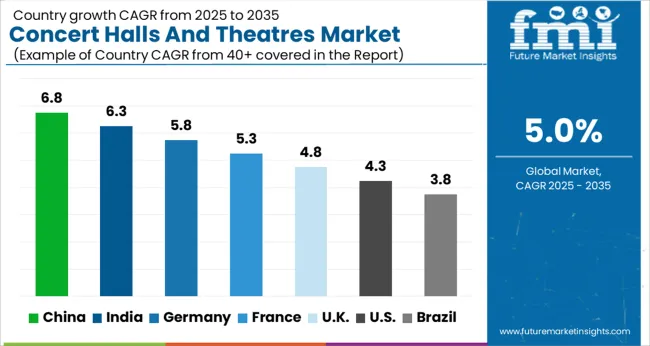
The global concert halls and theatres market is expanding at a steady 5.0% CAGR, driven by growing demand for live entertainment and cultural experiences. China leads with 7% growth, supported by increased investment in cultural infrastructure and rising urban populations. India follows at 6%, fueled by expanding middle-class audiences and government initiatives promoting the arts. Germany reports 6% growth, reflecting strong cultural heritage and modern venue developments. The United Kingdom grows at 5%, driven by vibrant performing arts scenes and tourism. The United States, a mature market, records 4% growth, shaped by established entertainment industries and ongoing venue modernization. These countries collectively influence market trends through enhanced audience engagement, technological upgrades, and diversified programming. This report includes insights on 40+ countries; the top countries are shown here for reference.
Growing at a 7% CAGR, China concert halls and theatres market is rapidly transforming the cultural landscape with vibrant hubs of artistic expression. Massive investments in urban centers are fueling the construction of modern multi-purpose venues that host everything from traditional opera to global concerts. Government initiatives promote cultural tourism and arts funding, driving public engagement. Compared to Western markets, China is modernizing quickly, blending concerts, theatre, and large-scale events in single venues. Younger urban audiences show strong demand for diverse and international performances. Digital streaming helps expand audience reach beyond physical attendance. The market balances traditional heritage with contemporary trends amid strong growth momentum.
India concert halls and theatres market is expanding at a 6% CAGR, fueled by rising disposable incomes and increasing urban populations craving live entertainment. The market combines rich cultural heritage with growing interest in modern and international performing arts. Unlike China’s rapid modernization, India has a fragmented venue landscape with many smaller theatres alongside new investments in state-of-the-art auditoriums in major cities. Bollywood’s influence boosts demand for live music and theatrical productions. Government initiatives and private sponsorships work to revitalize traditional arts alongside contemporary shows. Digital platforms complement live events to increase accessibility despite affordability challenges in some regions.
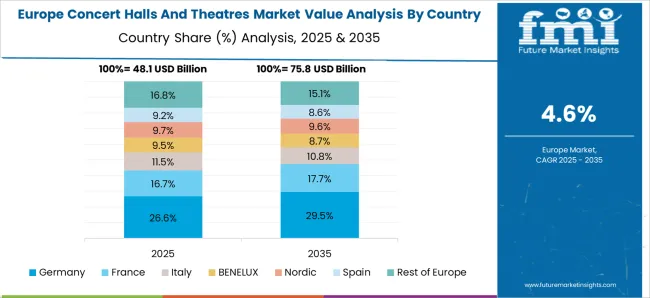
Germany concert halls and theatres market grows steadily at a 6% CAGR, supported by a long-standing tradition of classical music and theatre alongside contemporary arts. The country maintains a dense network of historic and modern venues funded by government subsidies and private patronage. Compared to Asia, Germany prioritizes artistic quality and cultural preservation, attracting local and international audiences. Investments focus on acoustic improvements, seating comfort, and accessibility. Innovative programming increasingly includes digital and interactive elements. Public and private collaboration fosters a vibrant cultural scene. Environmental sustainability is becoming integral to venue management practices.
The United Kingdom market for concert halls and theatres is growing at 5% CAGR, driven by a vibrant performing arts culture and extensive venue infrastructure. London remains a global arts hub, while regional cities invest in upgrading cultural venues. The market benefits from diverse funding sources, including public, private, and commercial. Compared to Germany, the UK emphasizes new and experimental theatre alongside classics. Post-pandemic hybrid models combining live and streamed performances expand audience reach. Inclusion and accessibility initiatives broaden participation, with partnerships supporting arts education and community engagement. Sustainability efforts focus on reducing venue environmental footprints.
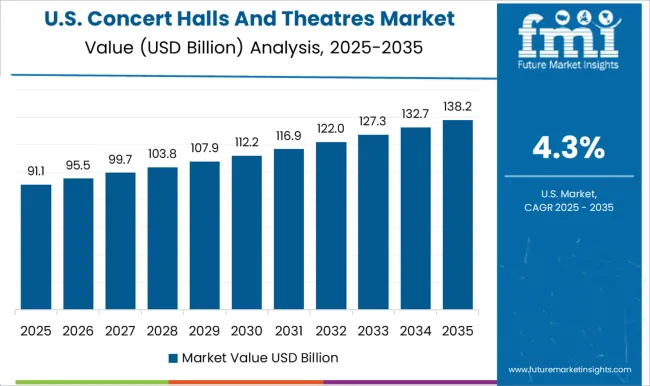
United States concert halls and theatres market grows at a 4% CAGR, fueled by a diverse performing arts ecosystem and iconic venues across major cities. Unlike Europe and Asia, the USA relies heavily on private philanthropy and commercial revenue alongside limited government grants. The market spans Broadway theatres, symphony halls, opera houses, and community stages, offering broad entertainment options. Advanced technology integration enhances lighting, acoustics, and audience experience. Post-pandemic, strong in-person attendance demand returns, supported by digital marketing and ticketing innovations. Challenges include high operating costs and competition from digital media, but creative programming and touring sustain interest.
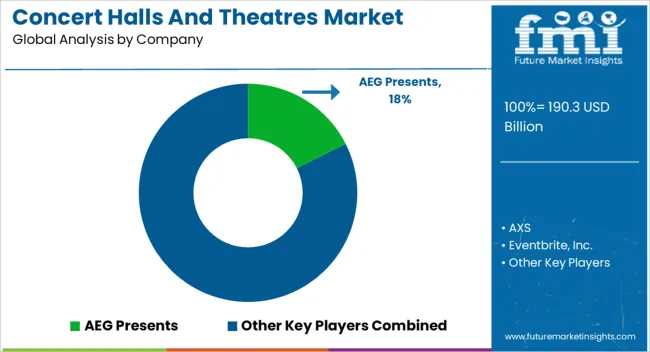
The concert halls and theatres market is evolving rapidly, driven by the growing demand for live entertainment experiences and advancements in ticketing and event management technologies. Key players in this market include AEG Presents, AXS, Eventbrite, Inc., Paciolan, Inc., Ticket Galaxy, Inc., Tickets.com, LLC, Ticketfly, Inc., ShowClix, Inc., Vendini, Inc., and Universe, Inc. These companies play pivotal roles in event promotion, ticket distribution, and venue management, enabling seamless audience engagement from booking to attendance.
AEG Presents stands out as a major promoter and operator of concert halls and theatres globally, while platforms like Eventbrite, AXS, and Ticketfly focus heavily on ticket sales and event discovery, often integrating social media and mobile capabilities to enhance user experience. Companies such as Paciolan and Tickets.com specialize in providing scalable ticketing solutions for venues, optimizing sales and data analytics for better operational efficiency.
The market is characterized by an increasing shift toward digital transformation, with innovations like mobile ticketing, contactless entry, dynamic pricing, and personalized marketing shaping the future of live events. Additionally, the COVID-19 pandemic accelerated the adoption of hybrid models that combine in-person performances with live streaming, expanding audience reach beyond physical venues. Geographically, North America and Europe dominate the market, but emerging markets in Asia-Pacific and Latin America are witnessing rapid growth due to rising disposable incomes and cultural investments. Going forward, sustainability efforts, enhanced health and safety protocols, and immersive technologies such as augmented and virtual reality experiences are expected to redefine audience engagement and operational strategies in concert halls and theatres worldwide.
MSG is well-known for its iconic venues like Madison Square Garden in New York. The company continues to innovate with renovations and upgrades, adding immersive technologies like 3D projection mapping and adaptive acoustics to improve the concert and theatre experience. MSG also emphasizes sustainable building practices, including the use of green materials and energy-efficient systems in its venues.
| Item | Value |
|---|---|
| Quantitative Units | USD 190.3 Billion |
| Type | Theatres, Concert halls, and Opera houses |
| Programming & Events | Live events and performances, Classical music concerts, Opera performances, and Theatre productions |
| Event Frequency | Year-round, Seasonal, and Special |
| Regions Covered | North America, Europe, Asia-Pacific, Latin America, Middle East & Africa |
| Country Covered | United States, Canada, Germany, France, United Kingdom, China, Japan, India, Brazil, South Africa |
| Key Companies Profiled | AEG Presents, AXS, Eventbrite, Inc., Paciolan, Inc., Ticket Galaxy, Inc., Tickets.com, LLC, Ticketfly, Inc., ShowClix, Inc., Vendini, Inc., and Universe, Inc. |
| Additional Attributes | Dollar sales vary by venue type, including concert halls, opera houses, and multipurpose theatres; by region, with North America and Europe leading, and Asia-Pacific expanding rapidly; by revenue source, spanning ticketing, concessions, sponsorships, and merchandise. Growth is driven by technological upgrades, sustainability initiatives, and urban cultural investments. |
The global concert halls and theatres market is estimated to be valued at USD 190.3 billion in 2025.
The market size for the concert halls and theatres market is projected to reach USD 310.0 billion by 2035.
The concert halls and theatres market is expected to grow at a 5.0% CAGR between 2025 and 2035.
The key product types in concert halls and theatres market are theatres, concert halls and opera houses.
In terms of programming & events, live events and performances segment to command 38.9% share in the concert halls and theatres market in 2025.
Explore Similar Insights

Thank you!
You will receive an email from our Business Development Manager. Please be sure to check your SPAM/JUNK folder too.
Chat With
MaRIA